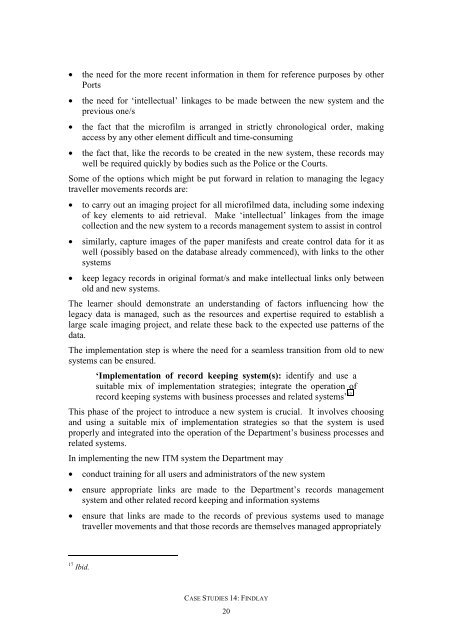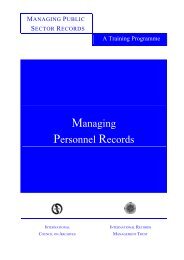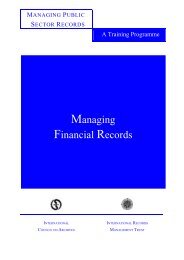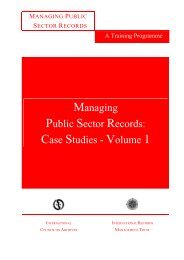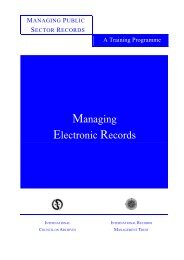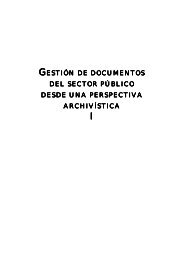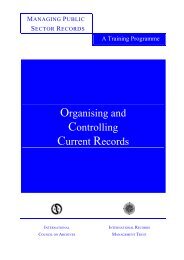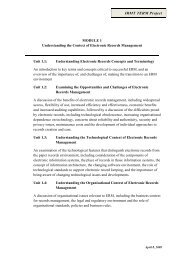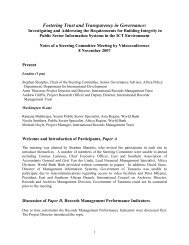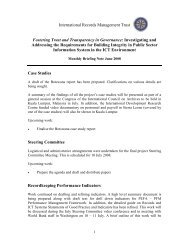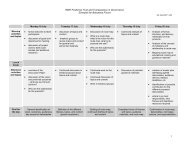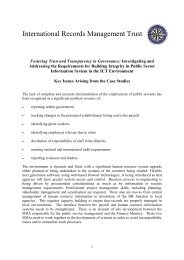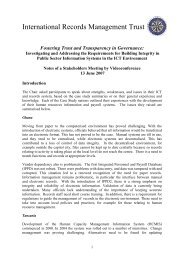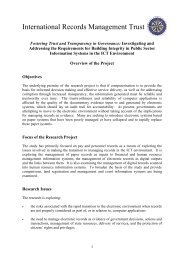managing public sector records: a study programme - International ...
managing public sector records: a study programme - International ...
managing public sector records: a study programme - International ...
You also want an ePaper? Increase the reach of your titles
YUMPU automatically turns print PDFs into web optimized ePapers that Google loves.
• the need for the more recent information in them for reference purposes by other<br />
Ports<br />
• the need for ‘intellectual’ linkages to be made between the new system and the<br />
previous one/s<br />
• the fact that the microfilm is arranged in strictly chronological order, making<br />
access by any other element difficult and time-consuming<br />
• the fact that, like the <strong>records</strong> to be created in the new system, these <strong>records</strong> may<br />
well be required quickly by bodies such as the Police or the Courts.<br />
Some of the options which might be put forward in relation to <strong>managing</strong> the legacy<br />
traveller movements <strong>records</strong> are:<br />
• to carry out an imaging project for all microfilmed data, including some indexing<br />
of key elements to aid retrieval. Make ‘intellectual’ linkages from the image<br />
collection and the new system to a <strong>records</strong> management system to assist in control<br />
• similarly, capture images of the paper manifests and create control data for it as<br />
well (possibly based on the database already commenced), with links to the other<br />
systems<br />
• keep legacy <strong>records</strong> in original format/s and make intellectual links only between<br />
old and new systems.<br />
The learner should demonstrate an understanding of factors influencing how the<br />
legacy data is managed, such as the resources and expertise required to establish a<br />
large scale imaging project, and relate these back to the expected use patterns of the<br />
data.<br />
The implementation step is where the need for a seamless transition from old to new<br />
systems can be ensured.<br />
‘Implementation of record keeping system(s): identify and use a<br />
suitable mix of implementation strategies; integrate the operation of<br />
record keeping systems with business processes and related systems’ 17<br />
This phase of the project to introduce a new system is crucial. It involves choosing<br />
and using a suitable mix of implementation strategies so that the system is used<br />
properly and integrated into the operation of the Department’s business processes and<br />
related systems.<br />
In implementing the new ITM system the Department may<br />
• conduct training for all users and administrators of the new system<br />
• ensure appropriate links are made to the Department’s <strong>records</strong> management<br />
system and other related record keeping and information systems<br />
• ensure that links are made to the <strong>records</strong> of previous systems used to manage<br />
traveller movements and that those <strong>records</strong> are themselves managed appropriately<br />
17 Ibid.<br />
CASE STUDIES 14: FINDLAY<br />
20


